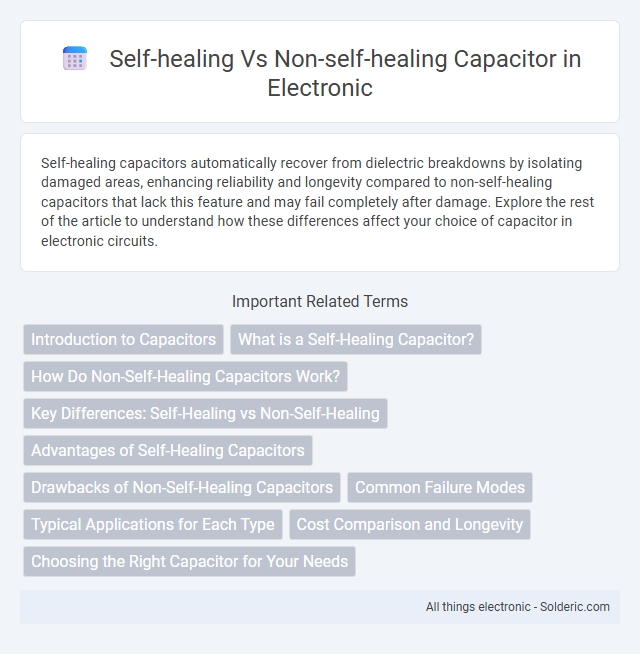Self-healing capacitors automatically recover from dielectric breakdowns by isolating damaged areas, enhancing reliability and longevity compared to non-self-healing capacitors that lack this feature and may fail completely after damage. Explore the rest of the article to understand how these differences affect your choice of capacitor in electronic circuits.
Comparison Table
| Feature | Self-Healing Capacitor | Non-Self-Healing Capacitor |
|---|---|---|
| Definition | Capacitor that can restore insulation after dielectric damage | Capacitor without capability to repair dielectric breakdown |
| Dielectric Damage Handling | Automatically isolates and repairs faults internally | Fails permanently upon dielectric breakdown |
| Reliability | Higher reliability and longer lifespan | Lower reliability, prone to permanent failure |
| Application | Used in power electronics, filtering, energy storage | Used in low-stress, cost-sensitive applications |
| Cost | Generally higher due to advanced design | Lower cost, simpler construction |
| Safety | Improved safety, reduces risk of catastrophic failure | Higher risk of failure and potential hazards |
Introduction to Capacitors
Capacitors are essential electronic components that store electrical energy in an electric field, widely used in circuits for filtering, buffering, and energy storage. Self-healing capacitors feature a dielectric layer that can repair minor internal damage, preserving functionality and extending lifespan, while non-self-healing capacitors lack this recovery capability and are more prone to permanent failure. The difference in construction directly impacts reliability, making self-healing capacitors preferable in applications requiring high durability and longevity.
What is a Self-Healing Capacitor?
A self-healing capacitor is an advanced electronic component designed to automatically repair minor dielectric breakdowns, maintaining functionality without complete failure. This capability is achieved through a special metallized film that vaporizes around fault sites, preventing permanent damage and extending the capacitor's lifespan. In contrast, non-self-healing capacitors lack this feature, making them more vulnerable to catastrophic failure when dielectric breakdown occurs.
How Do Non-Self-Healing Capacitors Work?
Non-self-healing capacitors function by using dielectric materials that cannot repair themselves after an electrical breakdown, causing permanent damage and loss of capacitance when a fault occurs. These capacitors rely on simple dielectric layers such as paper or film without metal layers designed to isolate faults, making them more susceptible to failures and shorter lifespans under stress. Understanding how non-self-healing capacitors operate helps you choose the right component for applications requiring durability and reliability.
Key Differences: Self-Healing vs Non-Self-Healing
Self-healing capacitors feature a dielectric material that can repair minor internal faults by isolating damaged areas, preserving capacitor functionality and extending lifespan, whereas non-self-healing capacitors lack this ability and are prone to permanent failure upon dielectric breakdown. The self-healing process ensures enhanced reliability in applications requiring long-term stability, while non-self-healing types may require more frequent replacement or maintenance. Understanding these key differences helps you choose the right capacitor technology for improved performance and durability in your electronic circuits.
Advantages of Self-Healing Capacitors
Self-healing capacitors offer significant advantages over non-self-healing types, including prolonged lifespan and enhanced reliability due to their ability to automatically repair dielectric breakdowns. These capacitors minimize failure risks by isolating faults and restoring normal function without manual intervention, reducing maintenance costs and downtime. Your electronic devices benefit from improved performance and safety when equipped with self-healing capacitors, especially in high-voltage applications.
Drawbacks of Non-Self-Healing Capacitors
Non-self-healing capacitors are prone to permanent damage when dielectric breakdown occurs, leading to reduced reliability and potential catastrophic failure. These capacitors cannot isolate faulted areas, causing short circuits and possible circuit disruption. Their limited fault tolerance results in shorter service life and increased maintenance costs compared to self-healing capacitors.
Common Failure Modes
Self-healing capacitors typically fail due to dielectric breakdown caused by voltage spikes or impurities, which trigger the capacitor's self-repair mechanism by vaporizing the faulted electrode area, restoring functionality. Non-self-healing capacitors often experience permanent short circuits or open circuits as a result of dielectric punctures or mechanical damage, leading to complete failure without recovery. Understanding these common failure modes is crucial for selecting capacitors in power electronics and high-reliability applications.
Typical Applications for Each Type
Self-healing capacitors are commonly used in power electronics, renewable energy systems, and electric vehicles due to their ability to recover from dielectric faults, enhancing reliability and lifespan. Non-self-healing capacitors find typical applications in low-stress environments such as audio circuits, filter networks, and non-critical low-voltage electronic devices where failure consequences are minimal. Choosing between these types depends on application requirements for durability, fault tolerance, and operating conditions.
Cost Comparison and Longevity
Self-healing capacitors typically have a higher upfront cost compared to non-self-healing capacitors due to their advanced dielectric materials and construction that allow automatic repair of minor dielectric breakdowns. Your investment in self-healing capacitors often results in longer operational lifespan and improved reliability, reducing maintenance and replacement expenses over time. In contrast, non-self-healing capacitors are more cost-effective initially but may require frequent replacements, leading to higher long-term costs and potential system downtime.
Choosing the Right Capacitor for Your Needs
Selecting the right capacitor involves understanding the benefits of self-healing versus non-self-healing types. Self-healing capacitors automatically repair dielectric breakdowns, enhancing reliability and extending lifespan in applications such as power electronics and renewable energy systems. Non-self-healing capacitors are typically less expensive but risk permanent failure upon dielectric damage, making them better suited for low-stress or cost-sensitive environments.
Self-healing vs non-self-healing capacitor Infographic

 solderic.com
solderic.com